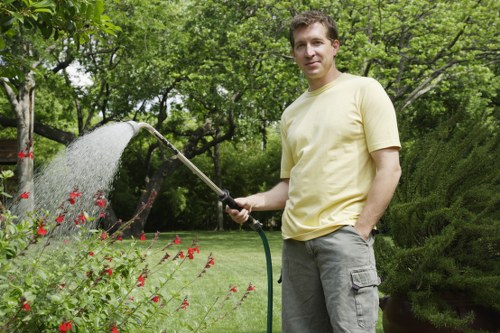Garden Fencing in Garden Fence Replacement: Enhance Your Outdoor Space

Garden fencing is an essential element in defining and enhancing your outdoor space. Whether you're aiming to increase privacy, add security, or simply improve the aesthetic appeal of your garden, choosing the right fence is crucial.
When it comes to garden fence replacement, understanding the various options available can help you make an informed decision that aligns with your needs and preferences. From traditional wooden fences to modern metal designs, each type offers unique benefits and drawbacks.
In this comprehensive guide, we'll explore the different types of garden fencing, factors to consider during replacement, and maintenance tips to ensure your new fence stands the test of time.
Why Replace Your Garden Fence?
Over time, garden fences can deteriorate due to weather conditions, wear and tear, or changes in your landscaping needs. Replacing an old or damaged fence can:
- Enhance Privacy: A new fence can provide the privacy you desire, creating a secluded backyard oasis.
- Improve Security: Replace worn-out fences with sturdier options to keep unwanted visitors and pests out.
- Boost Curb Appeal: A fresh, stylish fence can significantly improve the overall appearance of your property.
- Increase Property Value: Quality fencing can add value to your home, making it more attractive to potential buyers.

Understanding the reasons behind garden fence replacement is the first step in selecting the right type of fencing for your needs. Whether you prioritize functionality or aesthetics, there's a fencing solution tailored for you.
Before diving into the types of fences available, it's important to assess your specific requirements. Consider factors such as the primary purpose of the fence, your budget, and the existing style of your garden and home.
By taking these elements into account, you can narrow down your options and choose a fence that not only meets your practical needs but also complements your outdoor space beautifully.
Types of Garden Fencing
There is a wide range of garden fencing options available, each with its own set of advantages. Below, we'll delve into the most popular types to help you determine which one best suits your garden's needs.
1. Wooden Fences
Wooden fences are a timeless choice, known for their natural beauty and versatility. They can be customized in various styles, including picket, lattice, and panel designs.
Advantages:
- Aesthetic Appeal: Wood offers a warm and inviting look that blends seamlessly with most garden settings.
- Versatility: Easily painted or stained to match your garden's color scheme.
- Customization: Available in numerous designs and heights to fit your specific requirements.

Disadvantages:
- Requires regular maintenance to prevent rot, warping, and pest infestations.
- Can be more expensive over time due to upkeep costs.
Despite these drawbacks, wooden fences remain a popular choice for their classic look and functional benefits. Proper maintenance can extend their lifespan and keep them looking pristine.
2. Metal Fences
Metal fences, including wrought iron and aluminum, offer durability and a sleek appearance. They are ideal for those seeking a low-maintenance and long-lasting fencing solution.
Benefits:
- Durability: Resistant to harsh weather conditions, making them suitable for various climates.
- Low Maintenance: Typically require minimal upkeep compared to wooden fences.
- Security: Provides a robust barrier that enhances property security.
3. Vinyl Fences
Vinyl fencing has gained popularity due to its low maintenance and versatility. Available in a range of styles and colors, vinyl fences can mimic the look of wood without the associated upkeep.
Pros:
- Does not require painting or staining.
- Resistant to moisture, pests, and fading.
- Easily cleaned with soap and water.
Cons:
- Less sturdy than metal or wooden fences.
- Can become brittle in extreme temperatures.

Vinyl fences are an excellent option for those seeking a balance between aesthetics and functionality. They are particularly suited for modern gardens where a clean, streamlined look is desired.
Moreover, vinyl fencing is environmentally friendly as it can be recycled and does not emit harmful pollutants.
When considering garden fence replacement, vinyl offers a practical and stylish solution that can enhance your outdoor space without the hassle of constant maintenance.
Factors to Consider During Fence Replacement
Replacing your garden fence involves several considerations to ensure you select the best option for your needs. Here are the key factors to keep in mind:
1. Purpose
Determine the primary purpose of your fence. Is it for privacy, security, decoration, or to contain pets and children? Understanding the main function will guide your material and design choices.
2. Budget
Establish a budget for your fence replacement project. Different materials and styles come at varying price points, so it's essential to choose one that offers the best value within your financial constraints.
3. Aesthetic
Your fence should complement the overall design of your garden and home. Consider the color, style, and height to ensure it aligns with your outdoor space's aesthetics.
4. Local Regulations
Check any local building codes or homeowners' association rules that may dictate fence height, materials, or placement. Adhering to these regulations will prevent potential legal issues.
5. Maintenance
Consider the amount of time and effort you're willing to invest in maintaining your fence. Some materials require regular upkeep, while others are virtually maintenance-free.

6. Durability
Assess the durability of the fence material, especially in relation to your local climate. Materials like metal and vinyl are more resistant to weather changes compared to wood.
7. Installation
Decide whether you'll install the fence yourself or hire professionals. Professional installation ensures the fence is set up correctly, but it will add to the overall cost.
By carefully evaluating these factors, you can select a garden fence that not only meets your immediate needs but also stands the test of time, enhancing your garden for years to come.
Installation Tips for Garden Fence Replacement
Proper installation is crucial for the longevity and effectiveness of your new fence. Here are some tips to ensure a successful garden fence replacement:
1. Measure Accurately
Accurate measurements are essential to ensure that your new fence fits perfectly within the designated area. Measure the length, height, and any specific sections that may require adjustments.
2. Prepare the Ground
Clear the installation area of any debris, rocks, or vegetation. A well-prepared ground ensures that the fence stands firm and remains stable over time.
3. Use Quality Materials
Invest in high-quality materials to ensure that your fence is durable and long-lasting. This includes using strong posts, reliable fasteners, and weather-resistant finishes.
4. Follow Manufacturer’s Instructions
Carefully read and follow the installation instructions provided by the manufacturer. This ensures that the fence is assembled correctly and performs as intended.
5. Consider Professional Help
If you're unsure about the installation process or dealing with a complex design, hiring a professional can save you time and prevent potential mistakes.
By adhering to these installation tips, you can ensure that your new garden fence not only looks great but also provides the desired functionality and security.
Maintenance Tips for Longevity
Once your new fence is installed, proper maintenance is key to preserving its appearance and functionality. Here are some maintenance tips based on different fencing materials:
- Wooden Fences: Regularly treat with paint or stain to protect against moisture and pests. Inspect for rot and replace damaged panels as needed.
- Metal Fences: Check for rust or corrosion, especially in humid or coastal areas. Apply protective coatings or repaint as necessary.
- Vinyl Fences: Clean with mild soap and water to remove dirt and prevent discoloration. Inspect for cracks or chips and repair or replace sections as needed.
Additionally, periodically check the fence for any loose panels or posts and secure them to maintain stability. Proper maintenance not only extends the life of your fence but also keeps your garden looking its best.
Choosing the Right Professional
If you decide to hire a professional for your garden fence replacement, selecting the right contractor is essential. Consider the following when making your choice:
1. Experience and Expertise
Choose a contractor with a proven track record in fence installation and replacement. Experienced professionals are more likely to deliver quality results efficiently.
2. Reviews and References
Check online reviews and ask for references to gauge the contractor’s reputation and reliability. Positive feedback from previous clients is a good indicator of satisfactory work.
3. Licensing and Insurance
Ensure that the contractor is properly licensed and insured. This protects you from potential liabilities and ensures that the work meets industry standards.
4. Clear Communication
Effective communication is key to a successful project. Choose a contractor who listens to your needs, provides clear estimates, and keeps you informed throughout the installation process.
5. Competitive Pricing
While cost shouldn’t be the only factor, it’s important to get a fair price for the services rendered. Obtain multiple quotes to compare prices and services before making a decision.

By carefully selecting a qualified professional, you can ensure that your garden fence replacement is handled efficiently and to your satisfaction. A reputable contractor will deliver a fence that not only meets your functional needs but also enhances the beauty of your outdoor space.
Remember to discuss all aspects of the project beforehand, including timelines, costs, and any specific requirements you may have. Clear agreements help prevent misunderstandings and ensure that the final result aligns with your expectations.
With the right contractor, your new garden fence will serve as a long-lasting and attractive feature of your home, providing both beauty and functionality for years to come.
Conclusion
Replacing your garden fence is a significant investment that can greatly enhance the functionality and aesthetics of your outdoor space. By understanding the different types of fencing available, considering essential factors, and adhering to proper installation and maintenance practices, you can ensure a successful garden fence replacement.
Whether you prioritize privacy, security, or curb appeal, there is a fencing solution that perfectly fits your needs and complements your garden’s style.
Ready to transform your garden? Contact us today to explore our wide range of fencing options and schedule your garden fence replacement. Our team of experts is here to help you choose the perfect fence that meets your requirements and enhances your outdoor living space.